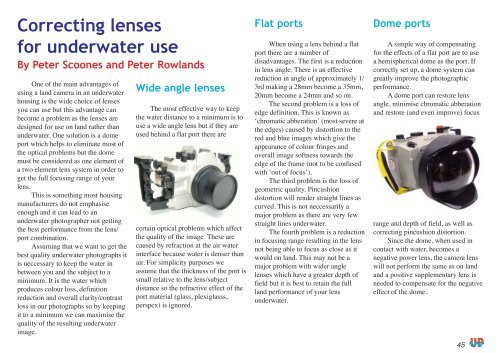Underwater Photography - SENSACIONES.org
Underwater Photography - SENSACIONES.org
Underwater Photography - SENSACIONES.org
Create successful ePaper yourself
Turn your PDF publications into a flip-book with our unique Google optimized e-Paper software.
Correcting lenses<br />
for underwater use<br />
By Peter Scoones and Peter Rowlands<br />
One of the main advantages of<br />
using a land camera in an underwater<br />
housing is the wide choice of lenses<br />
you can use but this advantage can<br />
become a problem as the lenses are<br />
designed for use on land rather than<br />
underwater. One solution is a dome<br />
port which helps to eliminate most of<br />
the optical problems but the dome<br />
must be considered as one element of<br />
a two element lens system in order to<br />
get the full focusing range of your<br />
lens.<br />
This is something most housing<br />
manufacturers do not emphasise<br />
enough and it can lead to an<br />
underwater photographer not getting<br />
the best performance from the lens/<br />
port combination.<br />
Assuming that we want to get the<br />
best quality underwater photographs it<br />
is neccessary to keep the water in<br />
between you and the subject to a<br />
minimum. It is the water which<br />
produces colour loss, definition<br />
reduction and overall clarity/contrast<br />
loss in our photographs so by keeping<br />
it to a minimum we can maximise the<br />
quality of the resulting underwater<br />
image.<br />
Wide angle lenses<br />
The most effective way to keep<br />
the water distance to a minimum is to<br />
use a wide angle lens but if they are<br />
used behind a flat port there are<br />
certain optical problems which affect<br />
the quality of the image. These are<br />
caused by refraction at the air water<br />
interface because water is denser than<br />
air. For simplicity purposes we<br />
assume that the thickness of the port is<br />
small relative to the lens/subject<br />
distance so the refractive effect of the<br />
port material (glass, plexiglasss,<br />
perspex) is ignored.<br />
Flat ports<br />
When using a lens behind a flat<br />
port there are a number of<br />
disadvantages. The first is a reduction<br />
in lens angle. There is an effective<br />
reduction in angle of approximately 1/<br />
3rd making a 28mm become a 35mm,<br />
20mm become a 24mm and so on.<br />
The second problem is a loss of<br />
edge definition. This is known as<br />
‘chromatic abberation’ (most severe at<br />
the edges) caused by distortion to the<br />
red and blue images which give the<br />
appearance of colour fringes and<br />
overall image softness towards the<br />
edge of the frame (not to be confused<br />
with ‘out of focus’).<br />
The third problem is the loss of<br />
geometric quality. Pincushion<br />
distortion will render straight lines as<br />
curved. This is not neccessarily a<br />
major problem as there are very few<br />
straight lines underwater.<br />
The fourth problem is a reduction<br />
in focusing range resulting in the lens<br />
not being able to focus as close as it<br />
would on land. This may not be a<br />
major problem with wider angle<br />
lenses which have a greater depth of<br />
field but it is best to retain the full<br />
land performance of your lens<br />
underwater.<br />
Dome ports<br />
A simple way of compensating<br />
for the effects of a flat port are to use<br />
a hemispherical dome as the port. If<br />
correctly set up, a dome system can<br />
greatly improve the photographic<br />
performance.<br />
A dome port can restore lens<br />
angle, minimise chromatic abberation<br />
and restore (and even improve) focus<br />
range and depth of field, as well as<br />
correcting pincushion distortion.<br />
Since the dome, when used in<br />
contact with water, becomes a<br />
negative power lens, the camera lens<br />
will not perform the same as on land<br />
and a positive supplementary lens is<br />
needed to compensate for the negative<br />
effect of the dome.<br />
45
















